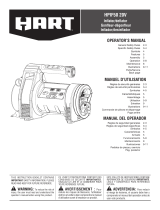
4
NORDIC
2.5 SERVICE
Your power tool should be serviced by a qualified specialist using only standard spare parts. This will
ensure that it meets the required safety standards.
⦁2.6 COMPRESSOR SAFETY WARNINGS
• Never point any compressor towards yourself or others.
• Keep the exterior of the compressor dry, clean and free from oil & grease. Always use a clean cloth when cleaning.
Never use brake fluids, gasoline, petroleum-based products, or any strong solvents to clean the unit. Following this
rule will reduce the risk of deterioration of the enclosure plastic.
• Do not exceed the pressure rating of any component in the system.
• Protect material lines and air lines from damage or puncture. Keep hose and power cord away from sharp objects,
chemical spills, oil, solvents and wet floors.
• Compressor service must be performed only by qualified repair personnel. Service or maintenance performed by
unqualified personnel may result in injury.
• Know your compressor. Read operator’s manual carefully. Learn its applications and limitations, as well as the
specific potential hazards related to this tool. Following this rule will reduce the risk of electric shock, fire or serious
injury.
• Risk of bursting. Do not preset the compressor to result in output pressure greater than marked maximum pressure
of item to be inflated. Do not use at pressure greater than 150psi.
• To reduce the risk of electric shock, so not expose to rain, Store indoors.
• Inspect unit for cracks, pin holes, or other imperfections that could cause the compressor to become unsafe. Never
cut or drill holes in the compressor.
• Make sure the hose is free of obstructions or snags. Entangled or snarled hoses can cause loss of balance or footing
and may become damaged.
• Use the compressor only for its intended use Do not alter or modify the unit from the original design or function.
• Always be aware that misuse or improper handling of this compressor can cause injury to yourself and others.
• Never leave a compressor unattended with the air hose attached to the item being inflated.
• Do not continue to use a compressor or hose that leaks air or does not function properly.
• Always disconnect the air supply and power supply before making adjustments, servicing or when the unit is not in
use.
• Do not attempt to pull or carry the compressor by the hoses.
• Always follow all safety rules recommended by the manufacturer. Following this rule will reduce risk of serious
personal injury.
• Do not use as a breathing device.
• Never direct a jet of compressed air toward people or animals. Take care not to blow dust and dirt towards yourself
or others. Following this rule will reduce the risk of serious personal injury.
• Protect your lungs. Wear a face or dust mask if the operation is dusty. Following this rule will reduce the risk of
serious personal injury.
• Do not use this unit to spray chemicals.
• Check damaged parts. Before further use of the compressor, a guard or other part that is damaged should be
carefully checked to determine that it will operate properly and perform its intended function. Check for alignment
of moving parts, binding of moving parts, breaking of parts, mounting and any other conditions that may affect its
operation.
















